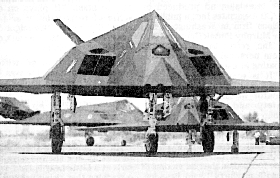 The flat-bottom design would seem to give a fine reflecting surface to ground based radars, not stealthy at all. The ventral surface is no doubt coated with radar-absorbing material, but that couldn’t be adequate or else they would have made the plane aerodynamic and just coated it all. Seems to me this design would only deflect radar originating from angles above the aircraft. But most radars are below.
The flat-bottom design would seem to give a fine reflecting surface to ground based radars, not stealthy at all. The ventral surface is no doubt coated with radar-absorbing material, but that couldn’t be adequate or else they would have made the plane aerodynamic and just coated it all. Seems to me this design would only deflect radar originating from angles above the aircraft. But most radars are below.Or, if you were coming straight in, head-on at the radar, you would be invisible, but that seems like a highly specialized mission, hardly worth a
 billion dollar aircraft.
billion dollar aircraft.For just flying over a ground based radar, it seems like you would show up like a giant Frisbee.
(And, on a related note, a stealth aircraft could not have its own radar, because invisibility makes you blind. See an earlier post on that thought).
Well, apparently, stealth design does work, but I can't see how.




Nice question, but surely you miss the obvious? If the underside of the aircraft is a perfect specular reflector, it will reflect any incident radar according to the normal rules of optics (see Physics 101). So unless the radar transmitter is vertically under the aircraft, any reflection will arrive at a location different from that of the transmitter. Ergo, it's invisible to the radar station. If the plane is above you, it's too late anyway. Radar is for seeing things coming, not "arrived". Irregular undersides of planes run the risk of specular reflection back to the transmitting site. Ergo, flat bottoms make for least chance of detection. (Unless the plane banks so as to present its belly directly toward the transmitter....) Voila!
ReplyDelete